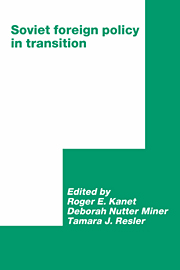Book contents
- Frontmatter
- Contents
- List of tables
- List of contributors
- Preface
- Introduction
- Part I The Soviet Union and the international political system
- Part II The Soviet Union and Europe
- 2 The changing Soviet–East European relationship
- 3 Soviet–Nordic relations in the era of perestroika and new thinking
- 4 Soviet signals to the Nordic countries during the Lithuanian crisis of 1990
- 5 Neutrality and new thinking
- Part III The Soviet Union and the developing world: global trends
- Part IV The Soviet Union and the developing world: regional and country case studies
- Part V Conclusion
- Index
5 - Neutrality and new thinking
Published online by Cambridge University Press: 05 February 2012
- Frontmatter
- Contents
- List of tables
- List of contributors
- Preface
- Introduction
- Part I The Soviet Union and the international political system
- Part II The Soviet Union and Europe
- 2 The changing Soviet–East European relationship
- 3 Soviet–Nordic relations in the era of perestroika and new thinking
- 4 Soviet signals to the Nordic countries during the Lithuanian crisis of 1990
- 5 Neutrality and new thinking
- Part III The Soviet Union and the developing world: global trends
- Part IV The Soviet Union and the developing world: regional and country case studies
- Part V Conclusion
- Index
Summary
Analysis of the USSR's attitudes toward neutrality and the European neutrals has never ranked high in the study of Soviet international relations. The few works on the subject refer to the special nature of the USSR's behavior toward Austria, Finland, Ireland, Sweden, or Switzerland. Some studies stress the consistency and continuity of Soviet policies and assume a deliberate strategy vis-à-vis the neutral states. Yet most analyses are either limited to the discussion of concepts of neutrality in the Soviet theory of international relations or the study of Moscow's relations with individual neutral countries. Few studies take a comparative perspective, analyzing the USSR's policies in the broader context of Soviet–European or East–West relations. In the absence of such an analytical framework, it is thus difficult to elaborate on distinctive patterns of Soviet attitudes toward neutrality and the European neutrals.
This is the more regrettable as the USSR's experience with neutrality may become more relevant for Soviet foreign policy. Gorbachev has pointed out that Soviet relations with the neutral states, particularly with Finland, serve as role models for the “common European home.” The newly independent countries of East-Central Europe and the Soviet republics seeking more independence from Moscow also are considering the option of neutrality and non-alliance. At the same time, the revolutionary changes in Europe have profound implications for the position of the neutral states and the very meaning of neutrality.
Information
- Type
- Chapter
- Information
- Soviet Foreign Policy in Transition , pp. 100 - 118Publisher: Cambridge University PressPrint publication year: 1992
